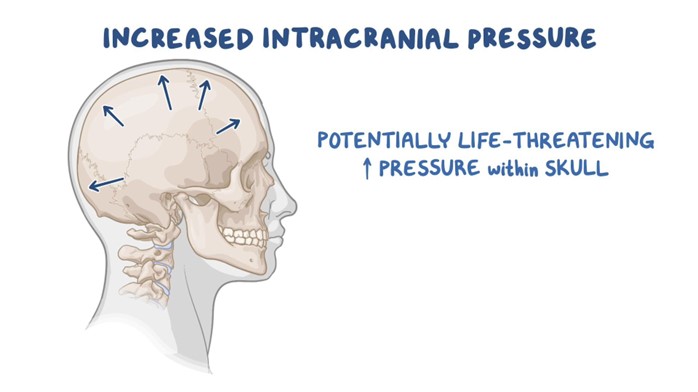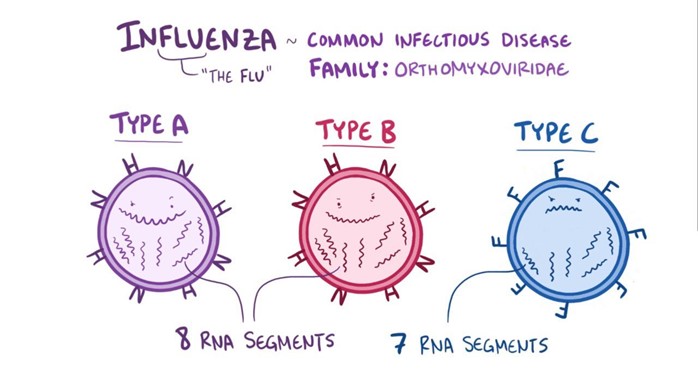A nurse is monitoring a client who had a cerebral aneurysm rupture. Which of the following findings should the nurse identify as a manifestation of increased intracranial pressure?
Hypertension
Tinnitus
Hypotension
Tachycardia
The Correct Answer is A
Choice A reason: Hypertension is a manifestation of increased intracranial pressure, as it reflects the body's attempt to maintain adequate cerebral perfusion pressure (CPP) and blood flow to the brain. CPP is the difference between the mean arterial pressure (MAP) and the intracranial pressure (ICP). When ICP rises, MAP must also rise to keep CPP constant and prevent cerebral ischemia. Hypertension is part of the Cushing's triad, which is a classic sign of increased ICP that also includes bradycardia and irregular respirations.
Choice B reason: Tinnitus is not a manifestation of increased intracranial pressure, as it does not affect the auditory system. Tinnitus is a ringing, buzzing, or hissing sound in the ears that can be caused by various factors, such as ear infections, noise exposure, medications, or aging. Tinnitus may be associated with other neurological conditions, such as Meniere's disease, acoustic neuroma, or multiple sclerosis, but not with increased ICP.
Choice C reason: Hypotension is not a manifestation of increased intracranial pressure, as it indicates a decrease in MAP and CPP, which can lead to cerebral ischemia and infarction. Hypotension can be caused by various factors, such as blood loss, dehydration, shock, or medications. Hypotension may worsen the outcome of increased ICP by reducing the oxygen and nutrient delivery to the brain.
Choice D reason: Tachycardia is not a manifestation of increased intracranial pressure, as it contradicts Cushing's triad. Tachycardia is an increase in heart rate that can be caused by various factors, such as anxiety, pain, fever, dehydration, or medications. Tachycardia may increase the oxygen demand and metabolic rate of the brain, which can exacerbate the effects of increased ICP.

Nursing Test Bank
Naxlex Comprehensive Predictor Exams
Related Questions
Correct Answer is B
Explanation
Choice A reason: Discipline in the school setting for improper handwashing is not an appropriate action by the nurse, as it may not prevent the spread of influenza or promote healthy behaviors. Influenza is a viral infection that affects the respiratory system and can be transmitted by direct or indirect contact with respiratory droplets from an infected person. Handwashing is one of the most effective ways to prevent the transmission of influenza and other infectious diseases, but it requires proper technique, frequency, and duration. The nurse should not punish or blame the students for their handwashing habits but rather educate and encourage them to wash their hands with soap and water for at least 20 seconds, especially before and after eating, after using the bathroom, after coughing or sneezing, and after touching potentially contaminated surfaces.
Choice B reason: Education regarding respiratory and hand hygiene is an appropriate action by the nurse, as it helps to prevent the spread of influenza and promote healthy behaviors. The nurse should provide accurate and relevant information to the students, staff, and parents about the causes, symptoms, prevention, and treatment of influenza. The nurse should also teach and demonstrate proper respiratory and hand hygiene practices, such as covering the mouth and nose with a tissue or elbow when coughing or sneezing, disposing of used tissues in a trash can, washing hands frequently with soap and water or using alcohol-based hand sanitizer, avoiding touching the eyes, nose, and mouth, and staying away from sick people.
Choice C reason: Running a mandatory flu clinic is not an appropriate action by the nurse, as it may not be feasible, ethical, or effective in preventing influenza. Influenza vaccination is one of the best ways to prevent influenza and its complications, but it requires informed consent, adequate supply, trained personnel, and appropriate timing. The nurse cannot force or coerce anyone to receive the flu vaccine without their permission or against their wishes. The nurse should respect the autonomy and preferences of the students, staff, and parents, and provide them with evidence-based information about the benefits and risks of influenza vaccination. The nurse should also collaborate with the health department and other community partners to organize voluntary flu clinics that are accessible, affordable, and convenient for those who want to receive the vaccine.
Choice D reason: Closing the school for 6 weeks is not an appropriate action by the nurse, as it may not be necessary, practical, or beneficial in preventing influenza. Influenza outbreaks can vary in severity, duration, and impact depending on several factors, such as the strain of the virus, the level of immunity in the population, the availability of vaccines and antiviral medications, and the implementation of preventive measures. The nurse should monitor the situation closely and follow the guidance of the health authorities regarding school closure decisions. The nurse should also consider the potential consequences of school closure on the student's education, socialization, nutrition, safety, and mental health. The nurse should weigh the benefits and harms of school closure against other alternatives, such as increasing ventilation, cleaning and disinfecting surfaces, screening for symptoms, isolating sick students or staff members, reducing class size or mixing groups.

Correct Answer is ["B","E"]
Explanation
Choice A reason: Continuing with the triage process is not an immediate intervention that needs to be taken by the triage nurse, as it may expose more people to the chemical hazard and worsen the situation. The triage nurse should stop the triage process and alert the emergency department staff and management about the potential contamination. The triage nurse should also follow the facility's emergency preparedness plan and protocols for dealing with chemical spills.
Choice B reason: Evacuating the emergency department is an immediate intervention that needs to be taken by the triage nurse, as it helps to protect the safety and health of the staff, clients, and visitors. The triage nurse should assist with evacuating everyone from the emergency department to a safe and designated area, away from the source of contamination. The triage nurse should also ensure that everyone is accounted for and that no one re-enters the emergency department until it is cleared by the authorities.
Choice C reason: Placing the client in a private room is not an immediate intervention that needs to be taken by the triage nurse, as it may not prevent the spread of contamination or provide adequate care to the client. The client who have been exposed to a chemical spill should not be moved to another area of the facility, as they may contaminate other people or surfaces along the way. The client should be kept in a separate and isolated area until they are decontaminated and assessed.
Choice D reason: Treating the client after contaminated items are removed is not an immediate intervention that needs to be taken by the triage nurse, as it may delay or compromise the care of the client. The client who has been exposed to a chemical spill should be treated as soon as possible, as some chemicals can cause serious or irreversible damage to the skin, eyes, lungs, or other organs. The triage nurse should provide basic life support measures, such as airway management, oxygen therapy, or bleeding control while wearing appropriate personal protective equipment (PPE). The triage nurse should also remove any contaminated clothing or jewelry from the client and place them in a sealed bag.
Choice E reason: Sending the client and EMS crew to decontamination is an immediate intervention that needs to be taken by the triage nurse, as it helps to remove or neutralize any harmful chemicals from their skin, hair, or clothing. The triage nurse should direct or escort the client and EMS crew to a designated decontamination area or unit, where they will undergo a thorough washing process with water and soap or other solutions. The triage nurse should also monitor their vital signs and symptoms during and after decontamination.
Whether you are a student looking to ace your exams or a practicing nurse seeking to enhance your expertise , our nursing education contents will empower you with the confidence and competence to make a difference in the lives of patients and become a respected leader in the healthcare field.
Visit Naxlex, invest in your future and unlock endless possibilities with our unparalleled nursing education contents today
Report Wrong Answer on the Current Question
Do you disagree with the answer? If yes, what is your expected answer? Explain.
Kindly be descriptive with the issue you are facing.
